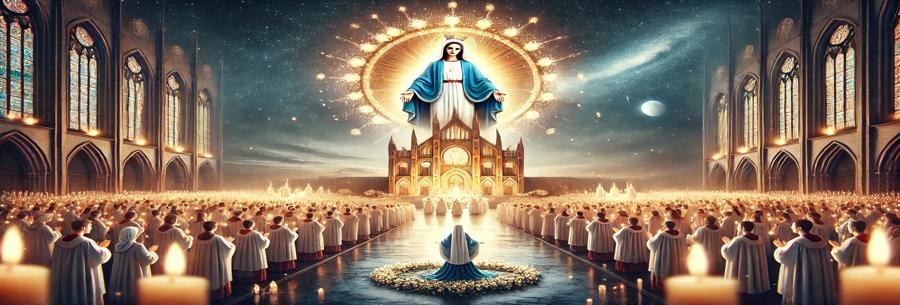How do churches around the world celebrate 8 December?
8 December, the feast of the Immaculate Conception, is a date of great importance for Christians, particularly Catholics. Celebrated with fervour in many parts of the world, this day honours the Virgin Mary, preserved from original sin from the moment of her conception. Traditions and practices vary from culture to culture and country to country, but they all share a common purpose: to pay tribute to Mary's purity and grace. This article explores the different ways in which churches and the faithful celebrate this Marian feast around the world.
The liturgical celebration at the heart of the feast
The solemn Mass of the Immaculate Conception
Mass is the centrepiece of celebrations on 8 December. All over the world, churches hold special services in honour of Mary. These Masses include:
Specific Bible readings: In particular, the story of the Annunciation (Luke 1:26-38), which highlights Mary's unique role in the plan of salvation.
Marian hymns: Hymns such as Ave Maria or Tota Pulchra Es are often sung.
A prayer of homage: Priests and faithful renew their consecration to the Virgin Mary, asking for her intercession and protection.
Eucharistic processions: In some regions, Mass is followed by processions in which the Eucharist or a statue of the Virgin is carried through the streets, accompanied by prayers and songs.
Traditions by country and region
In France: The lights of Lyon
One of the most famous traditions can be found in Lyon, where the feast of the Immaculate Conception is associated with the Festival of Lights: locals place luminous lights in their windows to thank the Virgin Mary, who is said to have protected the city from a plague epidemic in the 17th century.The Basilica of Fourvière, dedicated to Mary, becomes the centre of the celebrations, with masses and spectacular illuminations.
In Italy: Devotion in Rome
In Italy, a deeply Marian country, 8 December is a bank holiday. In Rome, the Pope traditionally goes to the Spanish Steps to lay a wreath of flowers at the foot of the statue of the Immaculate Conception. This gesture symbolises the Church's gratitude for Mary's maternal protection.
In Spain: Processions and songs
In many Spanish cities, such as Seville or Toledo, Marian processions take to the streets. The faithful sing traditional hymns in honour of the Virgin, accompanied by brass bands and floral decorations.
In the Philippines: A national fervour
In the Philippines, where Marian devotion is very strong, 8 December is a public holiday. Churches hold solemn masses, often preceded by novenas (nine days of prayer). Richly decorated statues of Mary are carried in procession, and communities come together for joyous celebrations.
In Latin America: A lively celebration
In countries such as Mexico, Peru and Argentina, the Immaculate Conception is celebrated with dances, collective prayers and floral offerings. These traditions often combine local cultural elements with Catholic religious practices.
Marian shrines and 8 December pilgrimages
Lourdes, France:
Lourdes, one of the world's most famous Marian shrines, is particularly lively on 8 December. Pilgrims take part in masses, torchlight processions and times of prayer in the grotto where the Virgin appeared to Bernadette Soubirous.
Guadalupe, Mexico:
Although Immaculate Conception Day is distinct from the feast of Our Lady of Guadalupe (12 December), many faithful begin their pilgrimage at this time to honour the Virgin under her various titles.
Fátima, Portugal:
At Fátima, the site of Marian apparitions in 1917, celebrations include solemn masses and Marian processions, attracting thousands of pilgrims.
Special prayers and devotions
The Rosary: The Rosary is prayed in a special way on 8 December. The faithful meditate on the joyful mysteries, particularly the Annunciation, where Mary accepts the mission God entrusts to her.
Novenas:In many parishes, a novena dedicated to the Immaculate Conception is organised before 8 December. These nine days of prayer prepare the hearts of the faithful to welcome the grace of this feast.
Consecration to Mary:The day of the Immaculate Conception is a special occasion for the faithful to renew their consecration to the Virgin, entrusting their lives and families to her.
The spiritual symbolism of these celebrations
A recognition of divine grace:
The celebrations on 8 December remind us that Mary is a perfect example of what God's grace can achieve. By honouring her purity, the faithful are invited to turn to God to seek to live in holiness.
A feast of light and hope:
Everywhere in the world, the feast of the Immaculate Conception is associated with light. Whether through the candles in Lyon or the illuminations in churches, this light symbolises the victory of good over evil, embodied by Mary.
On 8 December, churches around the world celebrate the Immaculate Conception with a wealth of traditions and spiritual practices. This day highlights God's infinite love for humanity and Mary's central place in the plan of salvation. Whether through prayers, processions or solemn masses, these celebrations remind all believers of the call to follow the Virgin's example in faith and purity.




















